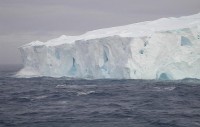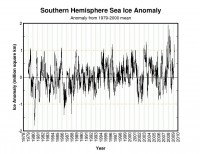By Greg Roberts, The Australian
ICE is expanding in much of Antarctica, contrary to the widespread public belief that global warming is melting the continental ice cap. The results of ice-core drilling and sea ice monitoring indicate there is no large-scale melting of ice over most of Antarctica, although experts are concerned at ice losses on the continent’s western coast.

Antarctica has 90 per cent of the Earth’s ice and 80 per cent of its fresh water. Extensive melting of Antarctic ice sheets would be required to raise sea levels substantially, and ice is melting in parts of west Antarctica. The destabilisation of the Wilkins ice shelf generated international headlines this month. However, the picture is very different in east Antarctica, which includes the territory claimed by Australia.
East Antarctica is four times the size of west Antarctica and parts of it are cooling. The Scientific Committee on Antarctic Research report prepared for last week’s meeting of Antarctic Treaty nations in Washington noted the South Pole had shown “significant cooling in recent decades”.
Australian Antarctic Division glaciology program head Ian Allison said sea ice losses in west Antarctica over the past 30 years had been more than offset by increases in the Ross Sea region, just one sector of east Antarctica. “Sea ice conditions have remained stable in Antarctica generally,” Dr Allison said.
The melting of sea ice—fast ice and pack ice—does not cause sea levels to rise because the ice is in the water. Sea levels may rise with losses from freshwater ice sheets on the polar caps. In Antarctica, these losses are in the form of icebergs calved from ice shelves formed by glacial movements on the mainland.
Last week, federal Environment Minister Peter Garrett said experts predicted sea level rises of up to 6m from Antarctic melting by 2100, but the worst case scenario foreshadowed by the SCAR report was a 1.25m rise. Mr Garrett insisted global warming was causing ice losses throughout Antarctica. “I don’t think there’s any doubt it is contributing to what we’ve seen both on the Wilkins shelf and more generally in Antarctica,” he said.
Dr Allison said there was not any evidence of significant change in the mass of ice shelves in east Antarctica nor any indication that its ice cap was melting. “The only significant calvings in Antarctica have been in the west,” he said. And he cautioned that calvings of the magnitude seen recently in west Antarctica might not be unusual. “Ice shelves in general have episodic carvings and there can be large icebergs breaking off—I’m talking 100km or 200km long—every 10 or 20 or 50 years.” Ice core drilling in the fast ice off Australia’s Davis Station in East Antarctica by the Antarctic Climate and Ecosystems Co-Operative Research Centre shows that last year, the ice had a maximum thickness of 1.89m, its densest in 10 years. The average thickness of the ice at Davis since the 1950s is 1.67m.
A paper to be published soon by the British Antarctic Survey in the journal Geophysical Research Letters is expected to confirm that over the past 30 years, the area of sea ice around the continent has expanded. Read story here.

See full image from Cryosphere today here.
See also this story from the Australian where a Russian sea captain says “I see just more and more ice, not less ice.”
RUSSIAN sea captain Dimitri Zinchenko has been steering ships through the pack ice of Antarctica for three decades and is waiting to see evidence of the global warming about which he has heard so much. Zinchenko’s vessel, the Spirit of Enderby, was commissioned in January last year to retrace the steps of the great Antarctic explorer Ernest Shackleton, marking the century of his Nimrod expedition of 1907-09. Spirit of Enderby was blocked by a wall of pack ice at the entrance to the Ross Sea, about 400km short of Shackleton’s base hut at Cape Royds. Zinchenko says it was the first time in 15 years that vessels were unable to penetrate the Ross Sea in January. The experience was consistent with his impression that pack ice is expanding, not contracting, as would be expected in a rapidly warming world. “I see just more and more ice, not less ice.”
Rodney Russ, whose New Zealand company Heritage Expeditions has operated tourist expeditions to Antarctica for 20 years, agrees. He says ships regularly used to able to reach the US base of McMurdo in summer, but ice has prevented them from doing so for several years. “Vessels are usually stopped 8km to 14km short of the base. A few years ago, that was often open water,” Russ says. “We have experienced quite severe ice conditions over the past decade. I have seen nothing in this region to suggest global warming is having an effect.”
Finally see this detailed analysis that puts the Wilkins in perspective to the massive Antarctic ice sheet and this analysis by John McLean showing why the so called Wilkins collapse was another NSIDC, BAS and mainstream media con job.
UPDATE: Finally a New Scientists story “Why Antarctic ice is growing despite global warming ” by Catherine Brahic reports CFCs and other ozone-depleting chemicals have given the South Pole respite from global warming. But only temporarily. According to John Turner of the British Antarctic Survey, the effect will last roughly another decade before Antarctic sea ice starts to decline as well. (ICECAP translation: 10 more years of funding ought to get me nicely to retirement) “By the end of the century we expect one third of Antarctic sea ice to disappear,” says Turner. (H/T Marc Morano, ClimateDepot.com)


